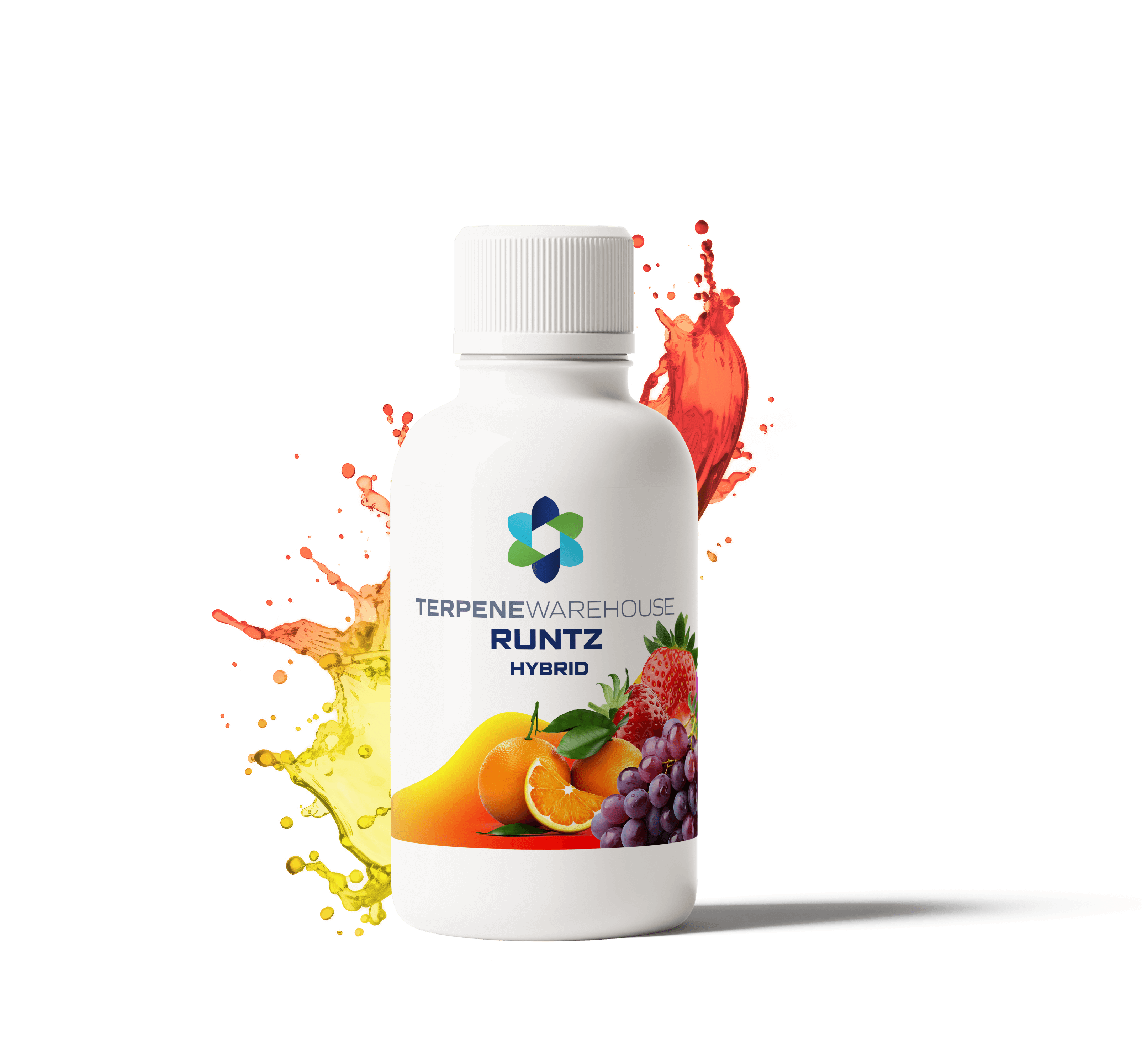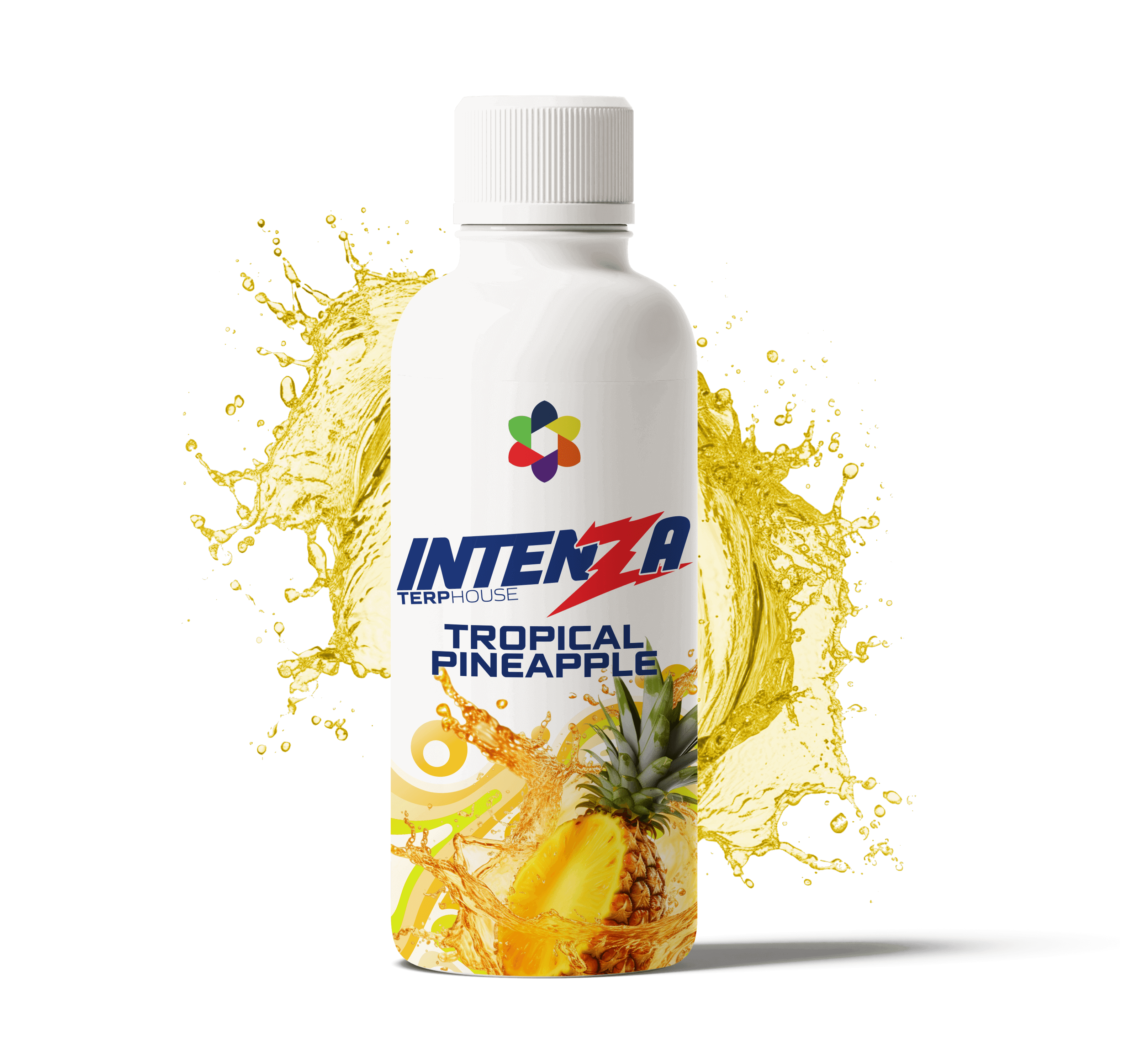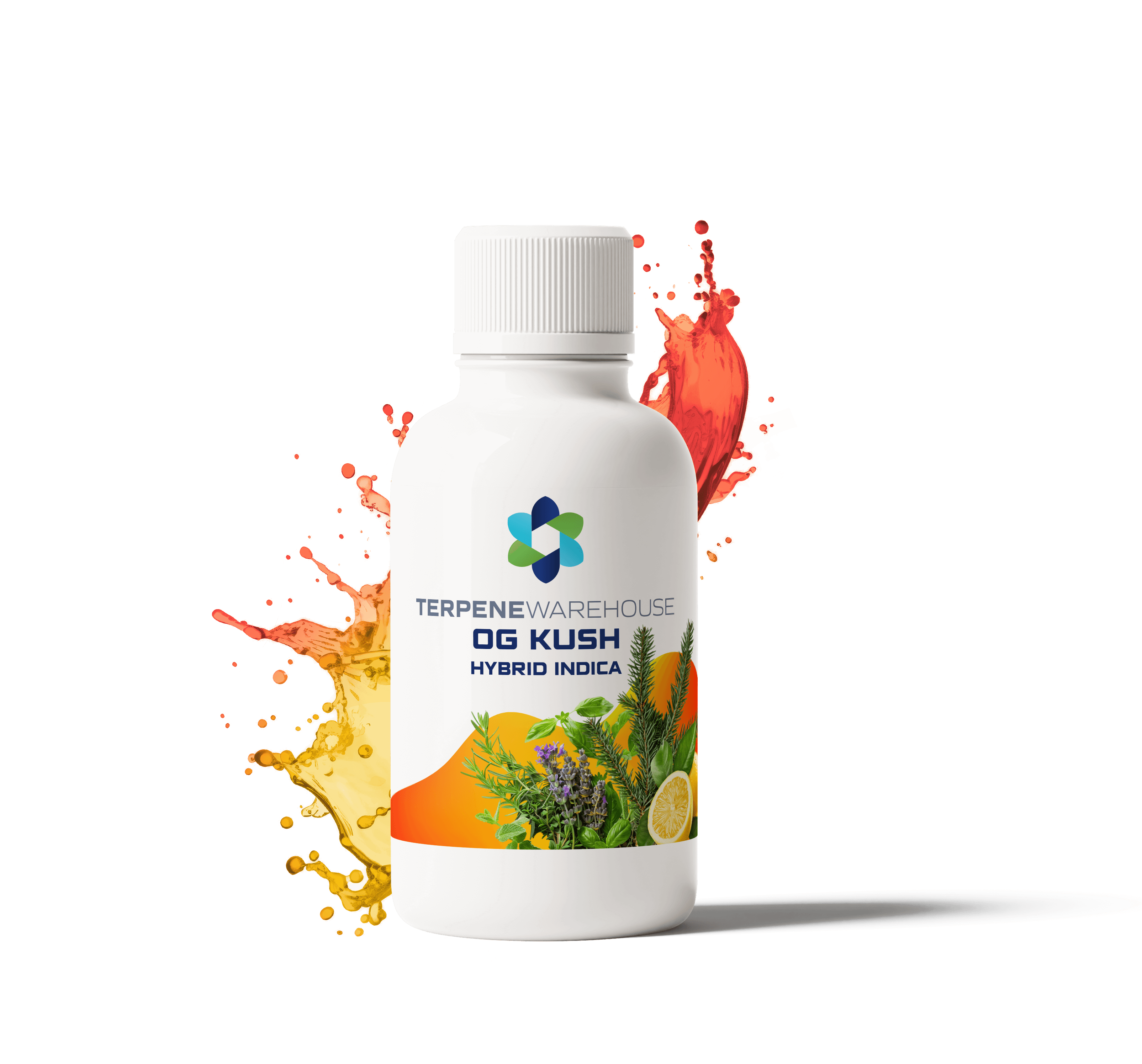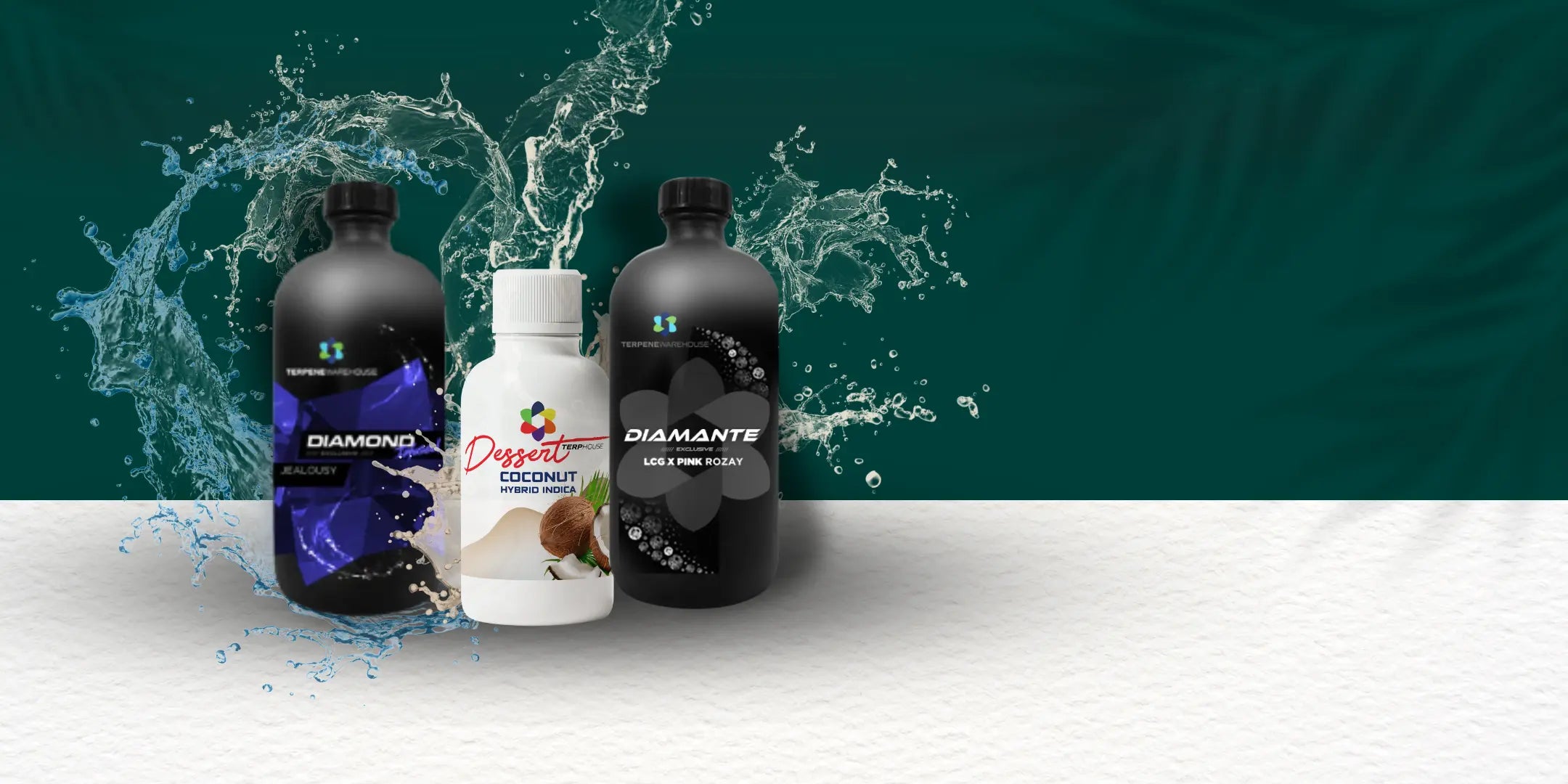Terpenes are natural compounds that shape your life far more than you might realize. Most people don’t even notice how terpenes guide their daily lives. Take shopping, for example—a simple ambient scent and flavor of a product can easily sway brand perception, conversion, and overall satisfaction in the right direction. That brings us to the core questions: what’s a terpene, and why is it so pivotal in a lot of food and products we consume?
What Are Terpenes?
Terpenes are the primary aromatic compounds found in the plant kingdom—and even in some insects. What is alluring and beneficial to humans in terpenes, according to plant physiology and science, actually acts as a defense mechanism against pests and pathogens firsthand, much like in other plants.
Terpene Definition and Chemical Structure
Terpenes are natural hydrocarbons that plants build from isoprene units and repeating five-carbon building blocks, which is why they’re grouped by size into families. Plants first snap those small units into short chains and then terpene synthases fold and reshape the chains into many ringed structures, creating the huge variety of aromas and effects we associate with different botanicals and cannabis profiles and their terpene content.
Why does this matter? This superb biomechanism is how growers, brands, and labs classify and measure terpenes across cannabis and other botanicals.
Where Are Terpenes Found in Nature?
Terpenes are mostly found in secretory systems of living creatures—not just plants, but also the animal kingdom. They use plant essential oils and terpenes to defend themselves. To ensure the safety of the primary biological cells, specialized structures such as resin ducts, cavities, and minute hairs store the terpenes. They also use pathways that are separate from the active tissues (for survival and growth). This way, they avoid self-toxicity.
What Do Terpenes Do in Plants?
They work as dynamic defense and signaling chemicals that can be released in minutes or in hours by species. How they work for animals and plants:
-
They deter herbivores and pathogens.
-
They hasten healing (from wounds).
-
They attract prey.
Example: Conifers stockpile terpene-rich resin in ducts for rapid, pressurized defense against bark beetles, while cannabis stores terpenes in surface trichomes that deter pests and slow pathogens.
What Is the Role of Terpenes in Cannabis and Hemp?
Distinct aroma and entourage effect are two key roles terpenes play in cannabis sativa or hemp, aside from defense. Other functions and implications of terps in cannabis and their therapeutic properties :
-
Terpenes have cannabimimetic potential. Meaning, they produce cannabinoid-like effects that influence certain receptors.
-
They are found concentrated on the flower’s trichomes, including various terpene alcohols, where reproduction matters.
-
They dictate trichome density, head size, and maturation stage.
-
Terpenes are volatile; drying, curing, and storage affect aroma and appeal.
Genetically identical plants can produce different types and amounts of terpenes depending on their growing conditions.
How Do Terpenes Work in the Human Body?
Terpenes and the Body’s Endocannabinoid System
Some terpenes (cannabis-derived or botanically derived) exhibit cannabinoid-like behavior, as witnessed in animal studies. They boost CB1 effects and track with adenosine A2A signaling. Meaning, they might support activities that calm or enhance neural activity. Bottom line: Terpenes sometimes look “cannabimimetic,” but their effects are context‑dependent.
Do Terpenes Get You High?
No. While terpenes can influence receptors and support cannabinoid activities, they do not cause any high. Psychoactivity or THC intoxication involves activating the CB1—and terpenes cannot do that. Terpenes do affect your mood and invite a sense of uplift, but they’re far from any mind-altering chemical compounds.
What Are the Effects of Terpenes?
|
Potential Effects |
Key Evidence |
What terpenes were mentioned |
|
Analgesia |
Blocking of A2A in mouse neuropathic pain models |
linalool, geraniol, α-humulene, and β-caryophyllene |
|
Cannabimimetic behaviors |
Generated cannabinoid tetrad components and boosted a CB1 agonist's pain relief/hypothermia in mice |
α-humulene, geraniol, linalool, β-pinene |
|
No CB1/CB2 effects |
Did not activate CB1/CB2 nor modulate Δ9‑THC activity, in human studies |
|
|
Sense of Mood/calm |
Influence on adenosine A2A, TRP channels, and related pathways may reduce pain and promote sedation |
Geraniol, linalool, α-humulene, and β-caryophyllene |
How Terpenes Influence Mood, Focus, and Relaxation
Terpenes may influence moments of mood, focus, and relaxation by targeting the following receptors:
-
A2A Pillow Effect: Some terpenes can turn up A2A’s “calm-it-down” signal
-
TRP chill channel: Some terpenes can quiet overactive sensory neurons by modulating TRP ion channels. Meaning, fewer sharp signals reach your brain.
Are Terpenes Psychoactive or Therapeutic?
Terpenes are not psychoactive. They can have potential therapeutic benefits, but they aren’t a cure or treatment for any health issues. They can nudge or act alongside other beneficial compounds in various cannabis strains (to help in body functions, possibly). However, they don’t contribute to any euphoric feeling.
Different Types of Terpenes and Their Effects
Myrcene: Sedating and Relaxing
-
Notes: green mango skin, resin-like hop, earthy, and a whisper of musk
-
Blending: mid or base with dense sweetness; great mediator for limonene and pinene
-
Potential: cited for its support for pain relief
-
Often among the top two terpenes in flower (mg/g range)
Limonene: Uplifting Citrus Aroma
-
Notes: Lemon zest, orange peel pit (depending on the isomer, it can smell sweet-citrus or turpentine-like)
-
Blending: effervescent top note; brightens citrus-pine blends; lifts myrcene/caryophyllene bases
-
Potential: mood uplift or stress management
Pinene: Sharp and Focused
-
Notes: Pine trees & needles, rosemary, eucalyptus (α‑pinene smells like bright camphor, and β‑pinene is more woody)
-
Blending: pairs well with “dank” bases; pairs well with limonene’s forest citrus and terpinolene’s herb-like notes
-
Potential: beta-pinene shows cannabinoid-like influence in CB1 and CB2
Linalool: Calming Lavender-Like Effect
-
Notes: Lavender, lilac, floral with a spicy undertone
-
Blending: forms the middle note; it feels like a citrus flower with limonene, a spiced floral with caryophyllene
-
Potential: anxiety-relieving, relaxing
Beta-Caryophyllene: Spicy and Anti-Inflammatory
-
Notes: Black pepper, clove, warm spice
-
Blending: provides a base beneath fruity or floral top notes; balances myrcene with limonene, inviting culinary nostalgia
-
Potential: CB receptor modulation, associated with anti-inflammatory and antioxidant properties
Terpinolene, Humulene, and Other Lesser-Known Terpenes
Terpinolene
-
Notes: Green apple, faint anise; “fresh forest” in certain sativa-dominant strains
-
Blending: little goes a long way, due to its very high odor activity
Humulene
-
Notes: Woody and tonic
-
Blending: deepens the base; gives toned-down richness to sweet profiles
Non-terpenoids
These include esters, aldehydes, thiols, and sulfur compounds. They’re found in plants too, alongside terpenes. They add depth and boost the effects of terpenes.
Terpenes vs Cannabinoids: What’s the Difference?
How Terpenes Enhance the Effects of THC and CBD
Terpenes enhance the effects through three aspects:
-
How to target body receptors: Since some terpenes behave like cannabinoids, they boost the effects of CB1 agonists (i.e., THC). In addition, they traverse some pathways that THC and CBD use too.
-
How the drug works: Full-spectrum (that includes terpenes) will always hit differently. Formulation ratios impact dose and byproducts because adding terpenes at high heat increases evaporation and changes the release of ingredients and gases. Adding terpene antioxidants to the packaging air cuts down the breakdown of THC by roughly 47%.
-
How it appeals to the user: aroma and flavor shape user satisfaction; adding a few terpenes can affect the mood easily.
All of these will depend on the terpene, dose, and product design.
What Is the Entourage Effect?
From a terpene-focused standpoint, entourage effect is when the cannabis terpenes influence what cannabinoids do in the body—sometimes synergistic, sometimes complementary. In the context of natural chemical biology, terpenes affect how signals are generated, how much cannabinoids reach tissues, and how much intact compound is delivered.
Are Terpenes More Than Just Aroma Compounds?
Yes, terpenes go beyond just being aromatic compounds.
-
Pre-harvest (in the plant): Many terpenes are specialized plant metabolites that help defend against pests, pathogens, and environmental stress. Like other secondary metabolites (including steroid saponins), their production is governed by plant stress signaling rather than by themselves.
-
Post-harvest (manufactured products): Some terpenes not only add flavor and possess therapeutic and medicinal uses, but they also help keep cannabinoids stable in products.
Terpenes Safe? Potential Side Effects and Considerations
Are Terpenes Safe to Inhale or Consume?
Yes! The Food and Drug Administration classified terpenes as generally recognized as safe (GRAS). Most terpenes occur naturally in plants and are found in your food. However, safety also depends on the type of terpene, product, and the person, as well as the potential health benefits they may provide. There’s no absolutely safe number yet when it comes to terpene dosages, but the following data might help:
-
For inhalables: Turpentine, mostly made up of α-pinene and β-pinene, has set limits of about 100 ppm over an 8-hour work period in many places.
-
For oral food products (e.g., citrus terpene flavored): up to about 20,000ppm in chewing gums, up to about 5,000 ppm in candies, and around 1,000ppm in beverages.
Note: These are not dosing targets. In addition, GRAS status is for food only.
Can You Be Allergic to Terpenes?
Yes. Consumers should ensure the total terpene is within the recommended limits. Trustworthy brands provide precise measurements to ensure a safe and enjoyable experience with terpene blends. Oxidation is the primary reason terpenes may irritate.
-
Some terpenes (e.g., limonene and linalool) can oxidize and form hydroperoxides that can irritate the skin or the airways.
-
Terpene reaction with OH can produce organic compounds (like carbonyls and aerosols) that contribute to eye, nose, and airway discomfort.
People with asthma (or sensitive to fragrant essential oils) should be wary of reactions when dealing with new terpene blends.
Where to Find Terpenes in Products
Terpenes in Cannabis Products (Vapes, Oils, Edibles)
Cannabis plants have that rich, complex, and dank smell because of the unique terpene makeup present. Whether it’s indica, sativa, or hybrid, a discerning nose can pick up how terpene-heavy a strain is. Beyond adding nuance to the scent, terpenes help shape the plant’s targeted potential benefits and are the key markers that distinguish one cultivar from another. According to a meta-analysis, adding a pleasant scent can increase a customer’s shopping satisfaction by 3-15% on average.
Vapes/Carts
Sometimes, concentrates use botanical terpenes as they offer consistent and sometimes cheaper options. Most single-cultivar vapes that use cannabis-derived terpenes (CDTs) come with a premium price and packaging. Precise terpene composition, mg/serving, and total percentage are available on most vapes.
Flowers
When buying regular or infused flowers, it’s best to check if they’ve been properly cured and stored. Fresh, well-handled flowers can give you the most authentic cannabis experience. However, the second session might not be as good as the first (with the same flower), especially since cannabis has monoterpenes that evaporate due to high vapor pressures.
Live Resin/Rosin
Live resin and rosin are known for having a more authentic terpene profile than other concentrates. Both boast high terpene content as they come from fresh-frozen material extracted at low temperature. The process is quite perfect with the chemical nature of terpene, which is volatile.
Oils
It’s important to check if the cannabinoid oil is full-spectrum, broad-spectrum, or an isolate because an isolate will have zero terpenes. They are only intended to be used for the potential benefits.
Edibles
Most edibles and beverages are flavored with natural or synthetic additives—not just terpenes. So, for users who have a sophisticated palate, it’s best to check the ingredients list before buying. Terpenes do blend well with any compounds, but high sugar can drown out terpene notes.
Terpenes in Essential Oils and Aromatherapy
Essential oils extracted from plants are made up mostly of terpenes and nonterpenoids. They are commonly used in cosmetic or wellness products, particularly aromatherapy. Inhaled terpene particles reach receptors swiftly and can also enter the respiratory system. Here’s a practical guide for other products:
-
Inhalation: can be used with a diffuser; no direct inhalation
-
Topical: diluted in skin-safe carrier oils
Do CBD Products Contain Terpenes?
Not necessarily. It must be a broad-spectrum or a full-spectrum CBD product to contain selected terpenes. Pure CBD isolate products, which contain no other compounds, most likely do not have terpenes (and are unscented). It’s still best to check the lab results to ensure what terpenes, built from isoprene units, are present and not present.
FAQs About Terpenes
Do Terpenes Affect Drug Tests?
No, terpenes do not show up in standard drug tests. Terpenes cannot bond to the same receptors that THC bonds to cause euphoria. Cannabinoid immunoassays or confirmatory GC-MS/LC-MS panels for drug testing mostly look for THC, precursor THCA, or secondary metabolite THC‑COOH.
Can You Smoke Terpenes by Themselves?
No, you cannot smoke pure terpenes. They are highly volatile aromas (with molecular weight below 300 Da) that bind to the olfactory receptors so well. Undiluted concentrated terpenes will harshly irritate your airways and will feel unpleasant. If you want a terpene-rich experience, go for cannabis whole flowers, as they are among the major components.
What’s the Difference Between Natural and Synthetic Terpenes?
The difference lies in how the terpenes are sourced. Natural means they’re sourced from plants through known extraction methods, like CO2, steam, or fractional distillation. Synthetic means they are assembled by chemical synthesis. No matter what the method, synthetic or natural, terpenes will still be chemically identical with each other.
How Long Do Terpenes Stay in Your System?
It depends on the terpene, dose, and consumption method. Here are some findings from a few studies:
-
Alpha-pinene (through inhalation): Mostly gone by the first day. (60% is taken up by the lungs during a 2-hour exposure; irritation appears 20 minutes after exposure to high concentration.)
-
Alpha-pinene (oral administration): terpene metabolite clears quickly, with roughly 1.4–1.6 hours for key early metabolites, and most are excreted within 24 hours.
-
R-limonene (oral administration): about 0.7 to 2.5 hours; complete excretion within 24 hours
-
3-carene (through inhalation): clearance is very quick, but residuals are seen beyond the first day
Do Terpenes Have a Taste or Just a Smell?
They have both! While terpenes have a high affinity with olfactory receptors, they affect flavor since it’s a combination of aroma (orthonasal and retronasal smell), taste (tongue), and sensations (cooling, tingling, burning, etc). Most terpenes are aroma-first, but they can influence the taste experience.







